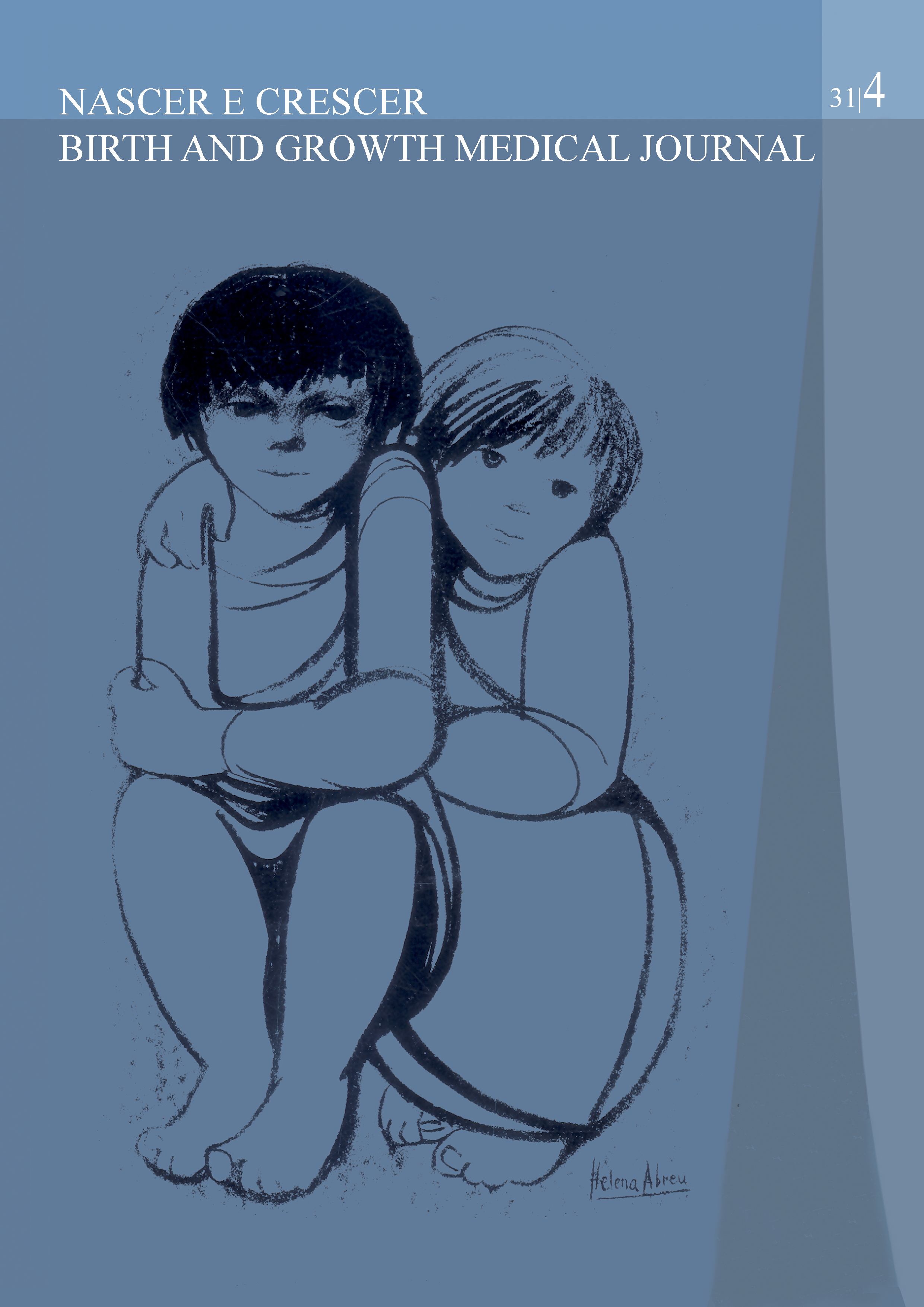Endocrine disorders in children with neurofibromatosis type 1: What to look for?
DOI:
https://doi.org/10.25753/BirthGrowthMJ.v31.i4.25986Keywords:
endocrine system diseases, growth and development, neurofibromatosis 1, PediatricsAbstract
Neurofibromatosis type 1 (NF1) is one of the most common genetic disorders, with a reported incidence of 1:3000. The condition is multisystemic, and diagnostic criteria have been recently revised as an international consensus recommendation. The clinical features evolve slowly and progressively and may often be absent in early childhood. Disorders of growth and endocrine conditions, although described for several decades in these children, are not included in the diagnostic criteria. However, they are relatively frequent and may be the presenting feature of optic pathway glioma. Due to its wide spectrum of health implications, children with NF1 are often followed at Pediatric consultation.
The aim of this article is to review the most frequent endocrine disorders in NF1 patients, what to look for, and when to refer patients to pediatric Endocrinology consultation.
Downloads
References
Legius E, Messiaen L, Wolkenstein P, Pancza P, Avery RA, Berman Y, et al. Revised diagnostic criteria for neurofibromatosis type 1 and Legius syndrome: an international consensus recommendation. Genet Med. 2021;23(8):1506-1513. doi: https://doi.org/10.1038/s41436-021-01170-5.
Hamosh A. Neurofibromatosis, type I; NF1, April, 2020. (Assessed august, 2021). Available at: https://www.omim.org/entry/162200.
Miller DT, Freedenberg D, Schorry E, Ullrich NJ, Viskochil D, Korf BR. Aap Council On Genetics, AAP American College Of Medical Genetics And Genomics. Health Supervision for Children With Neurofibromatosis Type 1. Pediatrics. 2019;143(5):e20190660. doi: https://doi.org/10.1542/peds.2019-0660.
Saxena KM. Endocrine manifestations of Neurofibromatosis children. Am J Dis Child. 1970;120(3):265-71. doi: https://doi.org/10.1001/archpedi.1970.02100080149020.
Giovannoni I, Callea F, Boldrini R, Inserra A, Cozza R, Francalanci P. Malignant Pheochromocytoma in a 16-Year-Old Patient with Neurofibromatosis Type 1. Pediatr Dev Pathol. 2014;17(2):126-9. doi: https://doi.org/10.2350/13-10-1397-CR.1.
Santoro C, Perrotta S, Picariello S, Scilipoti M, Cirillo M, Quaglietta L, et al. Pretreatment Endocrine Disorders Due to Optic Pathway Gliomas in Pediatric Neurofibromatosis Type 1: Multicenter Study. J Clin Endocrinol Metab. 2020;105(6):dgaa138. doi: https://doi.org/10.1210/clinem/dgaa138. PMID: 32294191.
Cambasio P, Galassi S, Palmiero M, Mastronuzzi A, Del Bufalo F, Capolino R, et al. Growth hormone excess in children with neurofibromatosis type-1 and optic glioma. Am J Med Genet. 2017;173(9):2353-8. doi: https://doi.org/10.1002/ajmg.a.38308.
Sani I, Albanese A. Endocrine Long-term Follow-up of Children with Neurofibromatosis type 1 and Optic Pathway Glioma. Horm Res Paediatr. 2017; 87:179-88. doi: https://doi.org/10.1159/000458525.
Cnossen MH, Stam EN, Cooiman L, Simonsz HJ, Stroink H, Oranje AP, et al. Endocrinological disorders and optic pathway glioma in children with neurofibromatosis. Pediatrics. 1997;100(4):667-70. doi: https://doi.org/10.1542/peds.100.4.667.
Carmi D, Shohat M, Metzker A, Dickerman Z. Growth, Puberty and endocrine function in patients with sporadic or familial Neurofibromatosis Type 1: a longitudinal study. Pediatrics. 1999;103(6 Pt 1):1257-62. doi: https://doi.org/10.1542/peds.103.6.1257.
Bizzarri C, Bottaro G. Endocrine implications of neurofibromatosis 1 in Childhood. Horm Res Paediatr. 2015;83(4):232-41. doi: https://doi.org/10.1159/000369802.
Kyritsi EM, Hasiotou M, Kanaka-Gantenbein C. Partial empty sella syndrome, GH deficiency and transient central adrenal insufficiency in a patient with NF1. Endocrine. 2020;69(2):377-85. doi: https://doi.org/10.1007/s12020-020-02351-z.
Clementi M, Milani S, Mammi I, Boni S, Monciotti C, Tenconi R. Neurofibromatosis Type 1 Growth Charts. Am J Med Genet. 1999; 87:317–23. doi: https://doi.org/10.1002/(SICI)1096-8628(19991203)87:4<317::AID-AJMG7>3.0.CO;2-X.
Bruzzi P, Sani I, Albanese A. Reversible Growth Hormone Excess in Two Girls with Neurofibromatosis Type 1 and Optic Pathway Glioma. Horm Res Paediatr 2015;84(6):414–22. doi: 10.1159/000440956.
Habiby R, Silverman B, Listernick R, Charrow J. Precocious puberty in children with neurofibromatosis type 1. J Pediatr. 1997;131(5):786-7. doi: https://doi.org/10.1016/s0022-3476(95)70449-3.
Bartolini E, Stagi S, Scalini P, Bianchi A, Ciccarone A, Mascalchi M. Central precocious puberty due to hypothalamic hamartoma in neurofibromatosis type 1. Hormones (Athens). 2016;15(1):144-6. doi: https://doi.org/10.14310/horm.2002.1631.
Kocova M, Kochova E, Sukarova-Angelovska E. Optic glioma and precocious puberty in a girl with neurofibromatosis type 1 carrying an R681X mutation of NF1: case report and review of the literature. BMC Endocrine Disorders. 2015;15:82-6. doi: https://doi.org/10.1186/s12902-015-0076-4.
Howell SJ, Wilton P, Lindberg A, Shaleta SM. Growth Hormone and Neurofibromatosis. Horm Res 2000;53(suppl 1):70–6. doi: https://doi.org/10.1159/000053208.
Josefson J, Listernick R, Fangusaro JR, Charrow J, Habiby R. Growth Hormone Excess in Children with Neurofibromatosis Type 1-Associated and Sporadic Optic Pathway Tumors. J Pediatr 2011;158(3):433-6. doi: https://doi.org/10.1016/j.jpeds.2010.09.013.
Neurofibromatosis conference statement. National Institutes of Health Consensus Development Conference. Arch. Neurol. 1988; 45: 575–8.
Downloads
Published
How to Cite
Issue
Section
License
Copyright (c) 2022 Maria Adriana Rangel, Marta Vila Real, Fátima Santos, Ana Luísa Leite, Rosa Arménia Campos

This work is licensed under a Creative Commons Attribution-NonCommercial 4.0 International License.
Copyright and Authors' Rights
All articles published in Nascer e Crescer - Birth and Growth Medical Journal are Open Access and comply with the requirements of funding agencies or academic institutions. For use by third parties, Nascer e Crescer - Birth and Growth Medical Journal adheres to the terms of the Creative Commons License "Attribution - Non-Commercial Use (CC-BY-NC)".
It is the author's responsibility to obtain permission to reproduce figures, tables, etc. from other publications.
Authors must submit a Conflict of Interest statement and an Authorship Form with the submission of the article. An e-mail will be sent to the corresponding author confirming receipt of the manuscript.
Authors are permitted to make their articles available in repositories at their home institutions, provided that they always indicate where the articles were published and adhere to the terms of the Creative Commons license.


